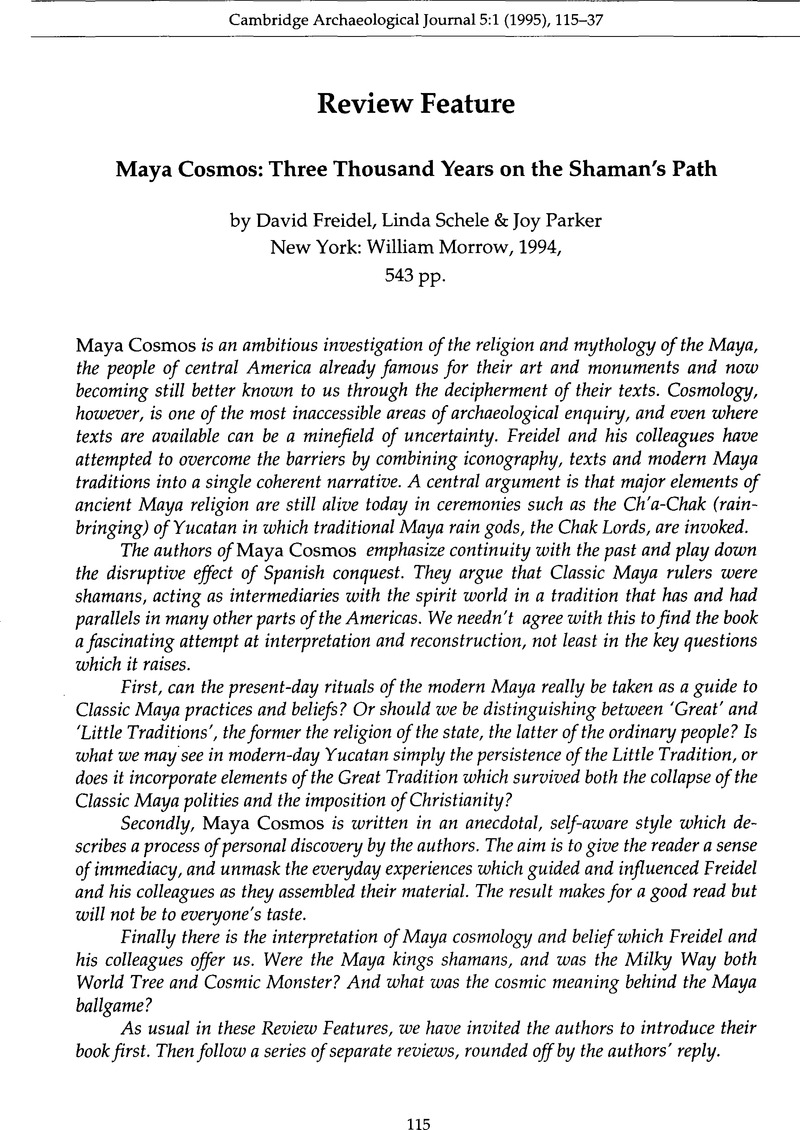No CrossRef data available.
Article contents
Maya Cosmos: Three Thousand Years on the Shaman's Path
Published online by Cambridge University Press: 22 December 2008
Abstract
An abstract is not available for this content so a preview has been provided. Please use the Get access link above for information on how to access this content.

- Type
- Review Feature
- Information
- Copyright
- Copyright © The McDonald Institute for Archaeological Research 1995
References
Andrews, E.Wyllys, V, 1994. The Organization of a Noble Residential Compound at the Center of Copan: Group 10L–2. Paper presented at the School of American Research Advance Seminar on the Archaeology of Copan, Honduras, Santa Fe, New Mexico.Google Scholar
Barrera-Vàsquez, A., 1980. Diccionario maya cordemex, mayaespañol, español-maya. Merida: Ediciones Cordemex.Google Scholar
Burger, R., 1992. Chavin and the Origins of Andean Civilization. New York (NY): Thames & Hudson.Google Scholar
Edmonson, M.S., 1982. The Ancient Future of the Itza: The Book of Chilam Balam of Tizimin. Austin (TX): University of Texas Press.Google Scholar
Edmonson, M.S., 1986. Heaven Born Merida and its Destiny: The Book of Chilam Balam of Chumayel. Austin (TX): University of Texas Press.Google Scholar
Eliade, M., 1964. Shamanism: Archaic Techniques of Ecstasy. New York (NY): Bollingen Foundation & Pantheon Books.Google Scholar
Fash, W., 1991. Scribes, Warriors, and Kings: The City of Copan and the Ancient Maya. London: Thames & Hudson.Google Scholar
Flannery, K., 1972. The cultural evolution of civilizations. Annual Review of Ecology and Systematic 3, 399–426.CrossRefGoogle Scholar
Frankfort, H., 1948 [1978]. Kingship and the Gods. (Reprint). Chicago (IL): University of Chicago Press.Google Scholar
Freidel, D.A. & Schele, L., 1988. Kingship in the Late Preclassic lowlands: the instruments and places of ritual power. American Anthropologist 90(3), 547–67.CrossRefGoogle Scholar
Fried, M., 1993. Old postulates and new China, in Configuration of Power: Holistic Anthropology in Theory and Practice, eds. Henderson, J.S. & Netherly, P.J.. Ithaca: Cornell University Press, 303–26.Google Scholar
Kubler, G., 1967. The Iconography of the Art of Teotihuacan. (Studies in Pre–Columbian Art and Archaeology 4.) Washington (DC): Dumbarton Oaks Center for Precolumbian Studies.Google Scholar
Langdon, E., 1992. Dau: shamanic power in Siona religion and medicine, in Portals of Power: Shamanism in South America, eds. Langdon, E. & Baer, G.. Albuquerque (NM): University of New Mexico Press, 41–61.Google Scholar
Langdon, E. & G., Baer (eds.), 1992. Portals of Power: Shamanism in South America. Albuquerque (NM): University of New Mexico Press.Google Scholar
Lounsbury, F.G., 1976. A rationale for the initial date of the Temple of the Cross at Palenque, in The Art, Iconography, and Dynastic History of Palenque, Part III: Proceedings of the Segunda Mesa Redonda de Palenque, ed. Robertson, M.G.. Pebble Beach (CA): Robert Louis Stevenson School, 211–24.Google Scholar
Packard, J.M., 1987. Sons of Heaven: A Portrait of the Japanese Monarchy. New York (NY): Collier Books.Google Scholar
Panofsky, E., 1955a. Iconography and iconology: an introduction to the study of Renaissance art, in Meaning in the Visual Arts. New York (NY): Doubleday, 26–54.Google Scholar
Panofsky, E., 1955b. Three decades of art history in the United States: impressions of a transplanted European, in Meaning in the Visual Arts. New York (NY): Doubleday, 321–46.Google Scholar
Redfield, R., 1957. Peasant Society and Culture. Chicago (IL): University of Chicago Press.Google Scholar
Reichel-Dolmatoff, G., 1971. Amazonian Cosmos: The Sexual and Religious Symbolism of the Tukano Indians. Chicago (IL): University of Chicago Press.Google Scholar
Reichel-Dolmatoff, G., 1978. Beyond the Milky Way: Hallucinatory Imagery of the Tukano Indians. Los Angeles (CA): UCLA Latin American Center, University of California, Los Angeles.Google Scholar
Roys, R.L., 1965. The Ritual of the Bacabs: A Boo of Maya Incantations. Norman (OK): University of Oklahoma Press.Google Scholar
Schele, L, 1992. Notebook for the XVI Maya Hieroglyphic Workshop at Texas. Austin (TX): University of Texas Press.Google Scholar
Schele, L. & Freidel, D.A., 1990. A Forest of Kinds: The Untold Story of the Ancient Maya. New York (NY):William Morrow.Google Scholar
Stark, B., 1991. Review of R. Sharer & D. Grove, Regional Perspectives on the Olmecs (Cambridge: Cambridge University Press). Journal of Field Archaeology 18, 234–8.CrossRefGoogle Scholar
Stuart, D., 1993. Historical inscriptions and the Copan collapse, in Lowland Maya Civilization of the Eight Century AD, eds. Sabloff, J.A. & Henderson, J.S.. Washington (DC): Dumbarton Oaks, 321–54.Google Scholar
Stuart, D. & Houston, S., 1994. Classic Maya Place Names. (Studies in Pre–Columbian Art & Archaeology 33.) Washington (DC): Dumbarton Oaks Research Library and Collection.Google Scholar
Taube, K., 1988. The Ancient Yucatec New Year Festival: The Liminal Period in Maya Ritual and Cosmology. Unpublished Ph.D dissertation, Yale University.Google Scholar
Taube, K., 1994. The Jade Hearth: Centrality, Rulership, and the Classic Maya Temple. A paper presented at the 1994 Dumbarton Oaks conference on Maya Architecture.Google Scholar
Tedlock, B., 1992. Time and the Highland Maya. Revised edition. Albuquerque (NM): University of New Mexico Press.Google Scholar
Tedlock, D., 1985. Popol Vuh: The Definitive Edition of the Mayan Book of the Dawn of Life and the Glories of God and Kings. New York (NY): Simon and Schuster.Google Scholar
Thompson, J.E.S., 1970. Maya History and Religion. Norman (OK): University of Oklahoma Press.Google Scholar
Thompson, J.E.S., 1973. Maya rulers of the Classic Period and the Divine Rights of Kings, in The Iconography of Middle American Sculpture, by Bernal, I.. New York (NY): The Metropolitan Museum of Art, 52–71.Google Scholar
Webster, D., 1994. Cultural Ecology and Culture History of the Resource Management at Copan, Honduras. Paper presented at the School of American Research Advanced Seminar on the Archaeology of Copan, Honduras, Santa Fe, New Mexico.Google Scholar
Webster, D., Sander, W.T. & van Rossum, P., 1992. A simulation of Copan population history and its implications. Ancient Mesoamerica 3, 185–97.CrossRefGoogle Scholar
Willey, G., 1988. Portraits in American Archaeology: Remembrances of Some Distinguished Americanists. Albuquerque (NM): University of New Mexico Press.Google Scholar




